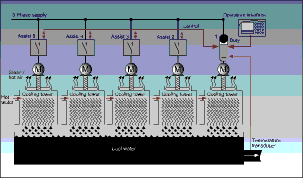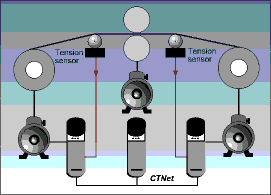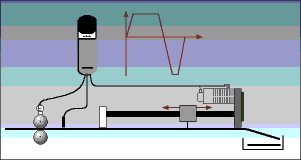
The ‘solutions’ concept adopted by Control Techniques SA is the company’s drive to make setting up, adjusting and software updating far simpler.
The goals were to produce products where the customer:
* No longer has to wait for 'the only person who knows how it works' when updating software
* No longer has to adopt the use of a new high-risk product, being the first company to have ever used it.
* No longer requires expensive updates to keep the system running.
Control Techniques has expended considerable effort, using its knowledge and experience to design standard, platform-independent software solutions. These are designed to plug easily into drive platforms, AC or DC, providing low-cost, low-risk drive solutions.
Three possible scenarios are:

Fan and pump duty-assist
The duty-assist control is an effective method of controlling multiple pumps or fans in parallel, to maintain the required process demand. Pumps and fans are often used in parallel banks to:
* Avoid motor overload.
* Guarantee security of supply (system redundancy).
* Reduce running cost due to system load cycles.
* Provide wide range of control and flexibility.
In a typical bank of three it is unusual to find two running and one on standby.
The duty is controlled by a PID loop which will maintain the process level required. If the demand exceeds the capacity that can be derived from the duty, then an assist starter will be enabled to assist with the delivery. If the demand continues to increase, additional starters will be called. When the demand decreases then each assist starter will be deselected to reduce the delivery.

Winder control
Many industrial processes involve handling material in web form, invariably this requires the material to be unwound and rewound.
Electric drives are ideally suited to provide accurate and effective control of material tension and have become the standard solution for winder application providing:
* Ability to either motor or regenerate enabling use in both coiling and uncoiling applications.
* Reduced running cost compared with mechanical equivalents.
* Improved reliability.
* Wide range of control and flexibility.
The final tension control solution will depend upon the material to be processed and the speed and diameter range over which it is to be run. Simple low pwerformance systems can be based upon straightforward open loop torque prediction, whilst more sensitive applications may require the tension loop to be closed by feedback from a loadcell. Some materials are better handled by running the drive in speed control with a dancing roll measuring the tension and modulating the winder speed.

Flying shear control
The flying shear is a common industrial application for cutting a continuous product to a set length at line speed, this means that the main production process is not interrupted, and so machine productivity is maximised.
The cutting tool is typically mounted on a carriage that moves either parallel to the product flow or at an angle across the product flow. The flying shear drive accelerates the carriage to synchronise with the line speed, at this point the cut tool can be activated. The carriage then decelerates and returns to its original position ready to cut again. There are also many other similar applications where a carriage must be synchronised at line speed and most of these can also be accommodated using the flying shear control software.
The drive is configured using real engineering units of choice such as mm or inches. This means that the configuration of the system is made very easy, through an operator interface or by entering configuration parameters directly on the drive.
Control Techniques
011 462 1740
| Tel: | +27 11 462 1740 |
| Email: | [email protected] |
| www: | www.controltechniques.com |
| Articles: | More information and articles about Nidec Control Techniques |

© Technews Publishing (Pty) Ltd | All Rights Reserved